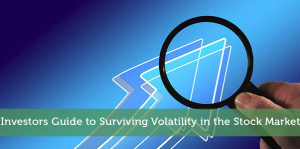Investors Guide To Surviving Volatility In The Stock Market
 It’s back!!! After well over a year of a smooth ride in the stock market, volatility is back with a vengeance. Even on days where the market closes down a few points, a closer look shows that the market swung wildly throughout the day and covered many hundred, if not thousand of points.
It’s back!!! After well over a year of a smooth ride in the stock market, volatility is back with a vengeance. Even on days where the market closes down a few points, a closer look shows that the market swung wildly throughout the day and covered many hundred, if not thousand of points.
To be honest, I don’t remember wild swings of volatility like this since the summer of 2011. Back then I was working for a high net worth planning firm and we were talking investors off the edge of the cliff.
Seeing as how many investors are feeling similar feelings today, I decided it would be a good time to help clear the air and put some things into perspective.
Your Guide To Surviving Volatility In The Stock Market
Recently I wrote about how we are headed for a bear market. However, I don’t think we are entering in one yet. I feel right now there are other factors at play. These include the following:
- Some investors selling and taking profits.
- Rising interest rates.
- The feeling that stocks are expensive.
Overall, the market was due for a pullback. It seemed like every trading day in January, the market was only rising. So it is only natural that eventually the market was going to fall.
It’s just that many didn’t think this type of volatility was going to happen so soon. So here are some things to keep in mind.
#1. Rising Interest Rates Change Plans
With interest rates hovering at near record lows, many investors were investing in safe stocks like utilities to earn a higher yield. But once interest rates began to rise, investors started to sell these stocks and move into less risky investments.
Add with the belief now of at least 3 more rate hikes this year, more investors are starting to sell.
#2. The Market Can’t Rise Forever
As I noted, the market was primarily rising. It needed to fall back and reset. And that is what it did. But here is why there was a dramatic drop in the last few sessions.
Most money managers set stop-loss limits for their clients. When the market dropped to a certain level, many stop-loss orders were triggered to lock in profits. When sellers outnumber buyers, the market is going to fall.
#3. No One Ever Knows When Volatility Will Strike
Based on the news and individual traders, no one saw this level of volatility coming. And this just goes to show that no investor is smarter than the market. On any given day, the market can rise or fall and it can do so calmly or with reckless abandon.
How To Deal With Volatility
#1. Review Your Plan
So how do you deal with volatility when it hits the market? Your first step should be to look back on your investment plan. Why are you investing? If you set up a well thought out plan, then this volatility doesn’t matter to you.
Take me for example. The volatility wowed me when it started. But it didn’t force me to react emotionally. I reviewed my investment plan, saw that nothing had changed, and ended up buying after a big drop.
#2. Turn Off The News
The job of the media is to get you emotionally involved. And they do a great job at this. The music, images and words they use all tell a story. You get worried and act emotionally, which costs you money in the long run.
You need to pay attention to what is happening, but then go back to the above point and review your plan. If nothing has changed, then turn off the news and go enjoy your day.
#3. Understand This Is Investing
Finally, you have to accept that volatility is part of the market. Last year was more of anomaly in that there was essentially zero volatility. We became more sensitive to volatility simply because we forgot what it was.
But it happens all of the time. And pullbacks like we are seeing happen all of the time as well. Historically, corrections in the market happen 4 times a year. This means that 4 times a year, on average, the market will drop 5-10% in a short amount of time.
Final Thoughts
Volatility can be a scary thing to both seasoned and new investors. But you have to understand that it is a part of investing and that the media is trying to get you emotionally attached.
The better you can control your emotions and follow your investment plan, the more likely you are going to be able to ride the wave and not get sucked into it.
So when volatility hits and you feel scared, refer back to this post to remember how to survive.
Note: This article originally appeared at Modest Money. Jon Dulin writes for Money Smart Guides, a personal finance blog that helps readers get out of debt and start investing for their future. He has been investing since he was 16 and has learned a lot through the years. He uses these investment lessons to help him be a more successful investor today.
Category: Breaking News




